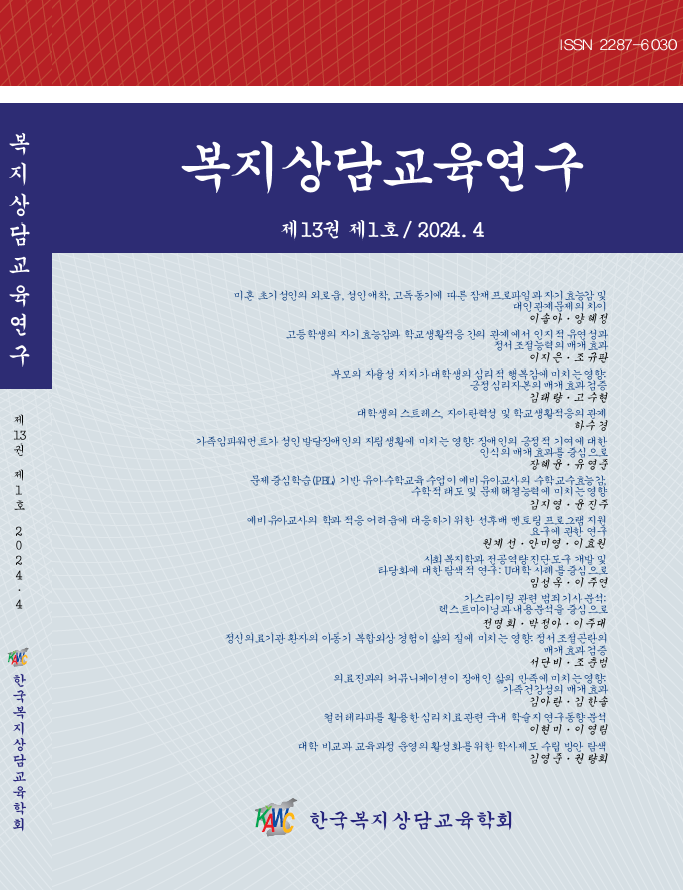컬러테라피를 활용한 심리치료 관련 국내 학술지 연구동향 분석
Analysis of Research Trends in Korean Academic Journals Related to Psychotherapy Using Color Therapy
- 한국복지상담교육학회
- 복지상담교육연구
- 제13권 제1호
-
2024.04289 - 309 (21 pages)
-
DOI : 10.20497/jwce.2024.13.1.289
- 497

본 연구의 목적은 최근 정부의 정신건강정책 혁신방안 발표에 따른 대안적 접근으로, 컬러테라피를 활용한 심리치료 관련 국내 학술지 연구동향을 분석하고, 후속연구를 위한 방향성을 제언하는 데 있다. 이를 위해 2009년부터 2023년까지 게재된 논문 29편을 분석하였다. 연구결과는 다음과 같다. 첫째, 2009년 부터 2023년까지 연구가 꾸준하게 수행되었고 2022년(17.24%)에 가장 높게 나타났다. 둘째, 국내 학회 18곳에서 발표되었으며 ‘미술치료연구’(20.69%)가 가장 많았다. 셋째, 연구대상은 성인의 비율이 가장 높았고, 대학생, 기타(혼합), 청소년, 아동, 노인 순이었다. 넷째, 연구방법 유형은 양적연구, 문헌연구, 질적연구, 혼합연구 순으로 나타났다. 다섯째, 연구내용 유형은 일반의 하위영역(자아, 정서․심리, 스트레스, 부적응 및 문제행동, 대인관계)과 진단의 하위영역(정서장애, 아동기장애, 뇌손상장애)에서 심리치료에 긍정적인 효과를 보였다. 이러한 연구 결과를 토대로 컬러테라피를 활용한 심리치료가 현장에서 유용하게 적용될 수 있음을 시사한다.
The purpose of this study is to analyze research trends in domestic academic journals related to psychotherapy using color therapy as an alternative approach following the government's recent announcement of a mental health policy innovation plan and to suggest directions for follow-up research. For this purpose, 29 papers published from 2009 to 2023 were analyzed. The research results are as follows. First, research was conducted steadily from 2009 to 2023, and was highest in 2022 (17.24%). Second, it was presented at 18 domestic academic conferences, and ‘art therapy research’ was the most common (20.69%). Third, the study subjects had the highest proportion of adults, followed by college students, others (mixed), adolescents, children, and the elderly. Fourth, the types of research methods were quantitative research, literature research, qualitative research, and mixed research. Fifth, the type of study content had a positive effect on psychotherapy in the general subareas(ego, emotions/psychology, stress, maladjustment & problem behavior, interpersonal relationships) and diagnostic subareas(emotional disorders, childhood disorders, brain injury disorders). Based on the research results, it is suggested that psychotherapy using color therapy can be usefully applied in the field.
Ⅰ. 서론
Ⅱ. 연구방법
Ⅲ. 연구결과
Ⅳ. 논의 및 결론
참고문헌
(0)
(0)